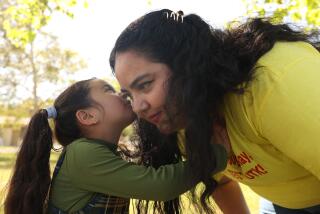Schools Enlisted in the Effort to Diagnose Spinal Curvature
- Share via
Many California schoolchildren will be bringing notes home this year--not about their academic performance or behavior, but about the curvature of their spine.
Abnormal spinal curvature is a problem that most people associate with aging, but it’s also a common problem in youth, affecting 2% to 4% of children between the ages of 10 and 16. The spinal abnormalities that children develop are very different from those commonly seen in older adults. In the elderly, the curve is usually an accentuation of the normal front-to-back S-shape of the spine; the problem in children is typically a lateral- or side-to-side-curvature known as scoliosis.
And, though spinal deformities among the elderly are usually the result of weakening and collapse of the spine’s bones (called vertebra), the cause of most cases of childhood scoliosis is unknown. (In a very small percentage of cases, however, there may be an underlying cause such as tumors or spinal cord abnormalities.)
Typically, scoliosis in children is slight and does not cause significant deformities or discomfort. (Although back pain is common during adolescence, children with mild scoliosis don’t appear to suffer from it any more frequently than others.) In some children, however, the curvature is severe or progressive to the point where it causes disfigurement and serious medical complications such as difficulty breathing.
California state law actually requires schools to screen children for this problem. Last year, about 50,000 middle-school students were examined for scoliosis in the Los Angeles Unified School district alone--and about 1,500 were referred to doctors for evaluation. The purpose of the examinations is to detect the more severe cases so treatment can slow or prevent worsening of the curvature.
However, scoliosis screening is controversial because it’s unclear that current nonsurgical treatments are effective. There is, for example, no good evidence to suggest that exercises (once routinely used for this purpose) are helpful. Even back braces--now the standard of care--may not work as well as once imagined. Although some studies have shown that they may help prevent curves in some growing children, others have found them to have no beneficial effect. For just this reason, the U.S. Preventive Services Task Force does not recommend for or against routine screening, but only suggest that physicians be alert for evidence of large curves when examining their adolescent patients.
So, what’s a parent to do? Since there is no risk to a child from the simple examination, many medical experts agree that children should be screened regularly, starting around the age of 10 (although scoliosis can develop at any age before a child’s skeleton fully matures, the majority of cases do not occur before this age).
Because it is more common in girls than in boys, the American Academy of Orthopedic Surgeons recommends screening girls twice--at ages 11 and 13--and boys once--at age 13 or 14. The American Academy of Pediatrics endorses a more rigorous screening protocol and recommends screening both boys and girls routinely at ages 10, 12, 14 and 16. (L.A. Unified screens girls in grade 7 and boys in grade 8.)
If an abnormal curve is found, consult with your child’s doctor. A recheck every four to six months may be all that is necessary if the curve is relatively small. If, however, the curve is large or your child is experiencing symptoms associated with it (such as pain or bladder or bowel problems), you should probably consult an orthopedic specialist.
Despite the controversy, back braces may be recommended to prevent moderate curves from worsening. Surgery--which usually involves the placement of metal rods alongside the spine to straighten it--is typically reserved for young children with rapidly progressing curves and adolescents with very large curves. Because of the risk of severe complications, including paralysis, a second opinion with a doctor specializing in children’s spine surgery is advisable if this procedure is recommended.
If your child brings home a note from school suggesting the possibility of scoliosis, don’t panic. Many of the children who come home with notes turn out to have no significant physical problem, and most of the children who do have scoliosis have such a slight curve that no problems will result.
*
Dr. Jonathan Fielding is the director of public health and the health officer for the Los Angeles County Department of Health Services. Dr. Valerie Ulene is a board-certified specialist in preventive medicine practicing in Los Angeles. Send questions by e-mail to: ourhealth @dhs.co.la.ca.us. Their column appears the second and fourth Mondays of the month.






